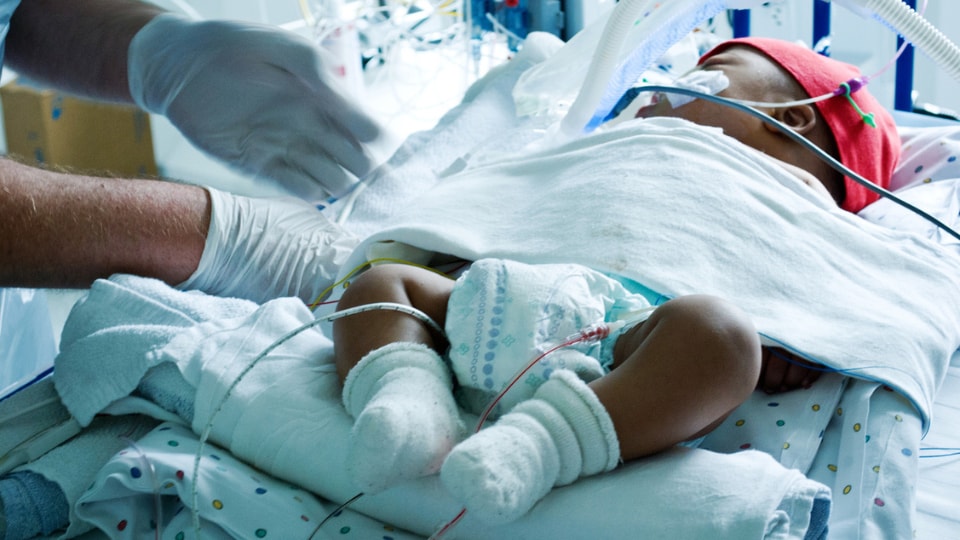Key points
- Esophageal atresia (ee-sof-uh-JEE-ul uh-TREE-zhuh) is when part of a baby’s esophagus (the tube connecting the mouth to the stomach) does not develop properly.
- Surgery to connect the esophagus helps the baby feed properly.
- About 1 in every 4,200 babies has esophageal atresia in the United States

What it is
Esophageal atresia is a birth defect of the esophagus, the swallowing tube that connects the mouth to the stomach.
In esophageal atresia, the esophagus has two separate sections—upper and lower—that do not connect. A baby with this condition is unable to pass food from the mouth to the stomach and may have difficulty breathing.
Esophageal atresia often occurs with a birth defect called tracheoesophageal fistula. This is when part of the esophagus connects to the trachea, or windpipe.
Nearly half of all babies born with esophageal atresia have one or more additional birth defects. These can include other problems with the digestive system (intestines and anus), heart, kidneys, or the ribs or spinal column.1
Types
There are four types of esophageal atresia:
Type A
The upper and lower parts of the esophagus do not connect and have closed ends. In this type, no parts of the esophagus attach to the trachea.
Type B
Type B is very rare. In this type, the upper part of the esophagus is attached to the trachea. The lower part of the esophagus has a closed end.
Type C
Type C is the most common type. In this type, the upper part of the esophagus has a closed end. The lower part of the esophagus is attached to the trachea.
Type D
Type D is the rarest and most severe. In this type, the upper and lower parts of the esophagus are not connected to each other. Each is connected separately to the trachea.

Risk factors
The causes of esophageal atresia among most infants are unknown. In some cases, esophageal atresia may occur because of abnormalities in the baby's genes. However, in most cases, esophageal atresia is thought to be caused by a combination of genes and other factors.
Research studies have also found some factors that may increase the risk of having a baby with esophageal atresia:
Diagnosis
Esophageal atresia is rarely diagnosed during pregnancy. Esophageal atresia is most commonly detected after birth when the baby first tries to feed and chokes or vomits. It can also be detected when a tube inserted in the baby’s nose or mouth cannot pass into the stomach. An x-ray can confirm that the tube stops in the upper esophagus.
Treatment
After the diagnosis, the baby needs surgery to connect the two ends of the esophagus. There may be multiple surgeries and other procedures or medications if:
- The baby’s repaired esophagus becomes too narrow for food to pass;
- The muscles of the esophagus do not work well enough to move food; or
- Digested food in the stomach keeps moving back up into the esophagus.
- Chittmittrapap S, Spitz L, Kiely EM, Brereton RJ. Oesophageal atresia and associated anomalies. Arch Dis Child. 1989;64(3):364-68.
- Green RF, Devine O, Crider KS, Olney RS, Archer N, Olshan AF, Shapira SK; National Birth Defects Prevention Study. Association of paternal age and risk for major congenital anomalies from the National Birth Defects Prevention Study, 1997 to 2004. Ann Epidemiol. 2010 Mar 31;20(3):241-9.
- Reefhuis J, Honein MA, Schieve LA, Correa A, Hobbs CA, Rasmussen SA. Assisted reproductive technology and major structural birth defects in the United States. Hum Reprod. 2009 Feb 1;24(2):360-6.
- Stallings, E. B., Isenburg, J. L., Rutkowski, R. E., Kirby, R. S., Nembhard, W.N., Sandidge, T., Villavicencio, S., Nguyen, H. H., McMahon, D. M., Nestoridi, E., Pabst, L. J., for the National Birth Defects Prevention Network. National population-based estimates for major birth defects, 2016–2020. Birth Defects Research. 2024 Jan;116(1), e2301.
